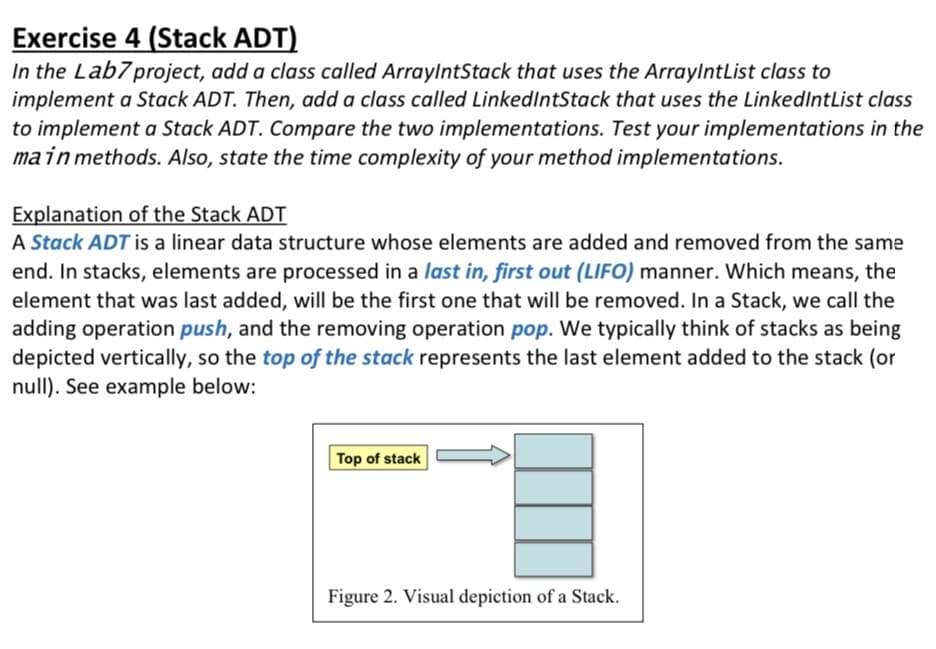In the Lab7project, add a class called ArraylntStack that uses the ArraylntList class to implement a Stack ADT. Then, add a class called LinkedIntStack that uses the LinkedIntList class to implement a Stack ADT. Compare the two implementations. Test your implementations in the mainmethods. Also, state the time complexity of your method implementations. Explanation of the Stack ADT A Stack ADT is a linear data structure whose elements are added and removed from the same end. In stacks, elements are processed in a last in, first out (LIFO) manner. Which means, the element that was last added, will be the first one that will be removed. In a Stack, we call the adding operation push, and the removing operation pop. We typically think of stacks as being depicted vertically, so the top of the stack represents the last element added to the stack (or null). See example below: Top of stack Figure 2. Visual depiction of a Stack.
In the Lab7project, add a class called ArraylntStack that uses the ArraylntList class to implement a Stack ADT. Then, add a class called LinkedIntStack that uses the LinkedIntList class to implement a Stack ADT. Compare the two implementations. Test your implementations in the mainmethods. Also, state the time complexity of your method implementations. Explanation of the Stack ADT A Stack ADT is a linear data structure whose elements are added and removed from the same end. In stacks, elements are processed in a last in, first out (LIFO) manner. Which means, the element that was last added, will be the first one that will be removed. In a Stack, we call the adding operation push, and the removing operation pop. We typically think of stacks as being depicted vertically, so the top of the stack represents the last element added to the stack (or null). See example below: Top of stack Figure 2. Visual depiction of a Stack.
C++ Programming: From Problem Analysis to Program Design
8th Edition
ISBN:9781337102087
Author:D. S. Malik
Publisher:D. S. Malik
Chapter18: Stacks And Queues
Section: Chapter Questions
Problem 16PE:
The implementation of a queue in an array, as given in this chapter, uses the variable count to...
Related questions
Question
Use java and indent the code properly.

Transcribed Image Text:Exercise 4 (Stack ADT)
In the Lab7project, add a class called ArraylntStack that uses the ArraylntList class to
implement a Stack ADT. Then, add a class called LinkedIntStack that uses the LinkedIntList class
to implement a Stack ADT. Compare the two implementations. Test your implementations in the
main methods. Also, state the time complexity of your method implementations.
Explanation of the Stack ADT
A Stack ADT is a linear data structure whose elements are added and removed from the same
end. In stacks, elements are processed in a last in, first out (LIF0) manner. Which means, the
element that was last added, will be the first one that will be removed. In a Stack, we call the
adding operation push, and the removing operation pop. We typically think of stacks as being
depicted vertically, so the top of the stack represents the last element added to the stack (or
null). See example below:
Top of stack
Figure 2. Visual depiction of a Stack.
Expert Solution
This question has been solved!
Explore an expertly crafted, step-by-step solution for a thorough understanding of key concepts.
This is a popular solution!
Trending now
This is a popular solution!
Step by step
Solved in 4 steps with 3 images

Knowledge Booster
Learn more about
Need a deep-dive on the concept behind this application? Look no further. Learn more about this topic, computer-science and related others by exploring similar questions and additional content below.Recommended textbooks for you

C++ Programming: From Problem Analysis to Program…
Computer Science
ISBN:
9781337102087
Author:
D. S. Malik
Publisher:
Cengage Learning

C++ Programming: From Problem Analysis to Program…
Computer Science
ISBN:
9781337102087
Author:
D. S. Malik
Publisher:
Cengage Learning